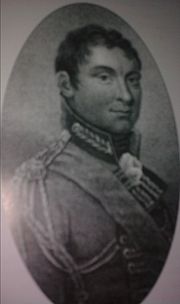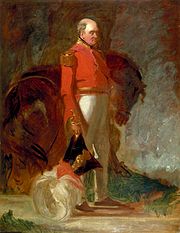| The Viscount Hill | |
|---|---|
 General Hill in army uniform, 1815 | |
| Born | August 11, 1772 |
| Died | December 10, 1842 (aged 70) |
| Place of birth | Hawkstone, Shropshire |
| Allegiance |
|
| Service/branch |
|
| Years of service | 1790–1842 |
| Rank | General |
| Commands held | II Corps |
| Battles/wars |
Napoleonic Wars Peninsular War |
| Awards | GCB, GCH, Military Order of William |
General Rowland Hill, 1st Viscount Hill GCB, GCH (11 August 1772 – 10 December 1842) served in the Napoleonic Wars as a trusted brigade, division and corps commander under the command of the Duke of Wellington. He became Commander-in-Chief of the British Army in 1828.
Early career[]
Educated at The King's School in Chester,[1] Hill was commissioned into 38th Foot in 1790.[2] He was promoted to lieutenant on 27 January 1791.[3] On 16 March 1791, after a period of leave, he was appointed to the 53rd Regiment of Foot.[4] He was asked to raise an independent company and given the rank of captain on 30 March 1793.[5] He served at the siege of Toulon in Autumn 1793 from where he carried the dispatches to London.[6] He then transferred to one of Major General Cornelius Cuyler's independent companies on 16 November 1793.[7] In 1794 he assisted Thomas Graham in raising the 90th Foot for which he was promoted to major on 27 May 1794[8] and to lieutenant-colonel on 26 July 1794.[9] He was promoted to colonel on 1 January 1800.[10] In 1801 he commanded the 90th Foot when they landed at Abu Qir Bay in Egypt as part of a force under Sir Ralph Abercromby: Hill was seriously wounded in the action when a musket ball hit his head.[6] In the ensuing weeks Hill helped drive the French forces out of Egypt.[6] Hill became a brigadier in 1803 and a major-general on 2 November 1805.[11]
The Peninsula[]
Hill commanded a brigade at the Battle of Roliça and also at the Battle of Vimeiro in 1808.[6] He participated in Sir John Moore's 1808–1809 campaign in Spain, commanding a brigade at the Battle of Corunna.[6] While serving under Wellington at the Second Battle of Porto, units of Hill's brigade launched an impromptu assault across the Douro River that ultimately routed Marshal Nicolas Soult's French corps from Oporto.[6]
Hill commanded the 2nd Infantry Division at the Battle of Talavera. The night before the battle, Marshal Claude Victor mounted a surprise attack, swept aside two battalions of the King's German Legion and seized a key elevation. As Hill later recounted, "I was sure it was the old Buffs, as usual, making some blunder."[12] Nevertheless, he led a reserve brigade forward in the dark. In the short clash that followed, Hill was briefly grabbed and nearly captured by a Frenchman, but his troops recovered the summit. This is the first occasion on which Hill supposedly swore.[13]
Still leading the 2nd Division during Marshal André Masséna's 1810 invasion of Portugal, Hill fought at the Battle of Bussaco.[6] In autumn 1811, Wellington placed Hill in independent command of 16,000 men watching Badajoz. On 28 October he led a successful raid on the French at the Battle of Arroyo dos Molinos. On 21 January 1812 he was appointed to the honorary position of Governor of Blackness Castle[14] and on 22 February 1812 he was appointed a KB.[15] He was made a Knight Grand Cross of the Portuguese Order of the Tower and Sword on 4 May 1812.[16]
In May 1812, after the capture of Badajoz, Hill led a second raid that destroyed a key bridge in the Battle of Almaraz.[6] While Wellington won the Battle of Salamanca, Hill protected Badajoz with an independent 18,000-man corps, including the British 2nd Division, John Hamilton's Portuguese division and William Erskine's 2nd Cavalry Division. He was promoted to lieutenant general on 30 December 1811.[17]
After the British capture of Madrid, Hill had responsibility for an army of 30,000 men.[6] Hill commanded the Right Column during the campaign and decisive British victory at the Battle of Vitoria on 21 June 1813.[6][18] Still in corps command, he fought in the Battle of the Pyrenees.[19] At Vitoria and in Wellington's invasion of southern France, Hill corps usually consisted of William Stewart's 2nd Division, the Portuguese Division (under John Hamilton, Francisco Silveira or Carlos Le Cor)[20] and Pablo Morillo's Spanish Division. For his leadership in these battles he was awarded a medal and two clasps on 7 October 1813.[21] He led the Right Corps at the Battle of Nivelle on 10 November 1813.[22]
On 13 December 1813, during the Battle of the Nive, Hill performed what may have been his finest work in his defence of St-Pierre d'Irube. With his 14,000 men and 10 guns isolated on the east bank of the Nive by a broken bridge, Hill held off the attacks of Marshal Nicolas Soult's 30,000 soldiers and 22 guns. He fought the battle with great skill and "was seen at every point of danger, and repeatedly led up rallied regiments in person to save what seemed like a lost battle ... He was even heard to swear."[13] Later, he fought at the Orthez and Toulouse. Wellington said, "The best of Hill is that I always know where to find him."[23] He was appointed Governor of Hull on 13 July 1814[24] and a commander of the Austro-Hungarian Order of Maria Theresa on 23 September 1815.[25]
Nicknamed "Daddy Hill", he looked after his troops and was adored by his men.[6] On one occasion, he provided a wounded officer who arrived at his headquarters with a lunch basket. Another time, a sergeant delivered a letter to Hill. Expecting nothing but a nod of thanks, the man was astonished when the general arranged for his supper and a place for him to stay for the night. The next day, Hill gave him food and a pound for the rest of his journey.[26]
He was also Member of Parliament (MP) for Shrewsbury from 1812[27] to 1814,[28] when he was raised to his peerage as Baron Hill of Almaraz and of Hawkestone in the county of Salop.[29][30]
Hill was also colonel of the 3rd Garrison Battalion from 14 January 1809,[31] colonel of the 94th Regiment of Foot from 23 September 1809,[32] colonel of the 72nd Regiment of Foot from 29 April 1815[33] and colonel of the Royal Regiment of Horse Guards from 19 November 1830.[34]
Waterloo and later career[]

Hill ready for the annual Waterloo anniversary banquet at Apsley House in 1836
At the Battle of Waterloo Hill commanded the II Corps.[6] He led the famous charge of Sir Frederick Adam's brigade against the Imperial Guard towards the end of the battle. For some time it was thought that he had fallen in the melee. He escaped unwounded, however, and continued with the army in France until its withdrawal in 1818.[6]
He received several awards from allied nations after the battle. On 21 August 1815, he was made Knight Commander of the Order of Maria Theresa of Austria and Knight of St George of Russia.[35] On 27 August 1815 the Dutch King William I made him a Commander of the exclusive Military Order of William. At the Coronation of George IV in 1821, Lord Hill bore the Standard of England in the procession from Westminster Hall to Westminster Abbey.[36] From 1828 to 1839, he succeeded the Duke of Wellington as Commander-in-Chief of the Forces.[6] He was also appointed Governor of Plymouth on 18 June 1830[37] and became Viscount Hill of Almaraz on 22 September 1842.[6]
A keen foxhunter, Rowland Hill was master of the North Shropshire Foxhounds until 1823.[38] The pack exists to this day and hunts the north of the County, including the grounds of his birthplace, Hawkstone Hall.[38] He later shared the Mastership with Sir Bellingham-Graham and Sir Edward Smythe, the hounds at this time being kennelled two miles south-east of Hawkstone Hall.[38] Rowland Hill also formed the Hawkstone Otter Hunt around 1800, which was maintained and hunted by successive Lords.[38]
He died at Hardwicke Grange, Hadnall, Shropshire on 10 December 1842.[6] He is buried in the churchyard at Hadnall, Shropshire.[6]

General Hill in later life
See also[]
- Viscount Hill
- Hawkstone Park
- Lord Hill's Column
Footnotes[]
- ↑ "Inspirational Alumni Members". The King's School Chester. http://www.kingschester.co.uk/extras/KingsAlumni/inspirationalAlumni.html. Retrieved 2 December 2011.
- ↑ "No. 13237". 14 September 1790. https://www.thegazette.co.uk/London/issue/13237/page/
- ↑ "No. 13278". 29 January 1791. https://www.thegazette.co.uk/London/issue/13278/page/
- ↑ "No. 13291". 15 March 1791. https://www.thegazette.co.uk/London/issue/13291/page/
- ↑ "No. 13514". 26 March 1793. https://www.thegazette.co.uk/London/issue/13514/page/
- ↑ 6.00 6.01 6.02 6.03 6.04 6.05 6.06 6.07 6.08 6.09 6.10 6.11 6.12 6.13 6.14 6.15 6.16 Rowland Hill at Oxford Dictionary of National Biography
- ↑ "No. 13593". 12 November 1793. https://www.thegazette.co.uk/London/issue/13593/page/
- ↑ "No. 13663". 24 May 1794. https://www.thegazette.co.uk/London/issue/13663/page/
- ↑ "No. 13687". 22 July 1794. https://www.thegazette.co.uk/London/issue/13687/page/
- ↑ "No. 15218". 31 December 1799. https://www.thegazette.co.uk/London/issue/15218/page/
- ↑ "No. 15856". 29 October 1805. https://www.thegazette.co.uk/London/issue/15856/page/
- ↑ Glover, p 108
- ↑ 13.0 13.1 Oman, p 118
- ↑ "No. 16564". 18 January 1812. https://www.thegazette.co.uk/London/issue/16564/page/
- ↑ "No. 16576". 18 February 1812. https://www.thegazette.co.uk/London/issue/16576/page/
- ↑ "No. 16599". 2 May 1812. https://www.thegazette.co.uk/London/issue/16599/page/
- ↑ "No. 16556". 28 December 1811. https://www.thegazette.co.uk/London/issue/16556/page/
- ↑ "No. 16887". 19 April 1814. https://www.thegazette.co.uk/London/issue/16887/page/
- ↑ "No. 16934". 13 September 1814. https://www.thegazette.co.uk/London/issue/16934/page/
- ↑ Oman, p 370-1
- ↑ "No. 16785". 5 October 1813. https://www.thegazette.co.uk/London/issue/16785/page/
- ↑ Burke, p. 231
- ↑ Glover, p 349
- ↑ "No. 16920". 26 July 1814. https://www.thegazette.co.uk/London/issue/16920/page/
- ↑ "No. 17064". 23 September 1815. https://www.thegazette.co.uk/London/issue/17064/page/
- ↑ Oman, p 115
- ↑ "No. 16660". 20 October 1812. https://www.thegazette.co.uk/London/issue/16660/page/
- ↑ "No. 16907". 11 June 1814. https://www.thegazette.co.uk/London/issue/16907/page/
- ↑ "Historical list of MPs: constituencies beginning with S, part 3". Leigh Rayment's House of Commons pages. http://www.leighrayment.com/commons/Scommons3.htm. Retrieved 13 January 2010.
- ↑ "No. 16894". 3 May 1814. https://www.thegazette.co.uk/London/issue/16894/page/
- ↑ "No. 16217". 10 January 1809. https://www.thegazette.co.uk/London/issue/16217/page/
- ↑ "No. 16299". 19 September 1809. https://www.thegazette.co.uk/London/issue/16299/page/
- ↑ "No. 17009". 6 May 1815. https://www.thegazette.co.uk/London/issue/17009/page/
- ↑ "No. 18747". 19 November 1830. https://www.thegazette.co.uk/London/issue/18747/page/
- ↑ The Complete Peerage, Volume VI. St Catherine Press, London. 1926. p. 520.
- ↑ "No. 17732". 3 August 1821. https://www.thegazette.co.uk/London/issue/17732/page/
- ↑ "No. 18699". 29 June 1830. https://www.thegazette.co.uk/London/issue/18699/page/
- ↑ 38.0 38.1 38.2 38.3 North Shropshire Hunt – Masters Roll
References[]
- Burke, Edmund (1813). The Annual register, or, A view of the history, politics, and literature for the year 1813, Volume 149..
- Glover, Michael (2001). The Peninsular War 1807–1814. London: Penguin Books. ISBN 0-14-139041-7.
- Oman, Charles (1993). Wellington's Army, 1809–1814. London: Greenhill. ISBN 0-947898-41-7.
This article incorporates text from a publication now in the public domain: Chisholm, Hugh, ed. Encyclopædia Britannica Cambridge University Press
External links[]
- Hansard 1803–2005: contributions in Parliament by the Viscount Hill
The original article can be found at Rowland Hill, 1st Viscount Hill and the edit history here.
